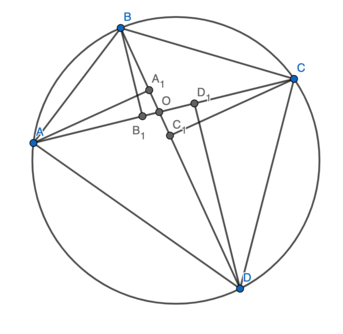Difference between revisions of "2021 AIME I Problems/Problem 11"
(→Problem) |
|||
| Line 3: | Line 3: | ||
==Solution== | ==Solution== | ||
| + | [[File:Leonard_my_dude's_image.png]] | ||
| + | |||
| + | Let <math>O</math> be the intersection of <math>AC</math> and <math>BD</math>. Let <math>\theta = \angle AOB</math>. | ||
| + | |||
| + | Firstly, since <math>\angle AA_1D = \angle AD_1D = 90^\circ</math>, we deduce that <math>AA_1D_1D</math> is cyclic. This implies that <math>\triangle A_1OD_1 \sim \triangle AOD</math>, with a ratio of <math>\frac{A_1O}{AO} = \cos \angle A_1OA = \cos \theta</math>. This means that <math>\frac{A_1D_1}{AD} = \cos \theta</math>. Similarly, <math>\frac{A_1B_1}{AB} = \frac{B_1C_1}{BC} = \frac{C_1D_1}{CD} = \cos \theta</math>. Hence <cmath>A_1B_1 + B_1C_1 + C_1D_1 + D_1A_1 = (AB + BC + CD + DA)\cos \theta</cmath> It therefore only remains to find <math>\cos \theta</math>. | ||
| + | |||
| + | From Ptolemy's theorem, we have that <math>(BC)(AC) = 4\times6+5\times7 = 59</math>. From Brahmagupta's Formula, <math>[ABCD] = \sqrt{(11-4)(11-5)(11-6)(11-7)} = 2\sqrt{210}</math>. But the area is also <math>\frac{1}{2}(BC)(AC)\sin\theta = \frac{59}{2}\sin\theta</math>, so <math>\sin \theta = \frac{4\sqrt{210}}{59} \implies \cos \theta = \frac{11}{59}</math>. Then the desired fraction is <math>(4+5+6+7)\cos\theta = \frac{242}{59}</math> for an answer of <math>\boxed{301}</math>. | ||
==See also== | ==See also== | ||
{{AIME box|year=2021|n=I|num-b=10|num-a=12}} | {{AIME box|year=2021|n=I|num-b=10|num-a=12}} | ||
{{MAA Notice}} | {{MAA Notice}} | ||
Revision as of 22:03, 11 March 2021
Problem
Let ![]() be a cyclic quadrilateral with
be a cyclic quadrilateral with ![]() and
and ![]() . Let
. Let ![]() and
and ![]() be the feet of the perpendiculars from
be the feet of the perpendiculars from ![]() and
and ![]() , respectively, to line
, respectively, to line ![]() and let
and let ![]() and
and ![]() be the feet of the perpendiculars from
be the feet of the perpendiculars from ![]() and
and ![]() respectively, to line
respectively, to line ![]() . The perimeter of
. The perimeter of ![]() is
is ![]() , where
, where ![]() and
and ![]() are relatively prime positive integers. Find
are relatively prime positive integers. Find ![]() .
.
Solution
Let ![]() be the intersection of
be the intersection of ![]() and
and ![]() . Let
. Let ![]() .
.
Firstly, since ![]() , we deduce that
, we deduce that ![]() is cyclic. This implies that
is cyclic. This implies that ![]() , with a ratio of
, with a ratio of ![]() . This means that
. This means that ![]() . Similarly,
. Similarly, ![]() . Hence
. Hence ![]() It therefore only remains to find
It therefore only remains to find ![]() .
.
From Ptolemy's theorem, we have that ![]() . From Brahmagupta's Formula,
. From Brahmagupta's Formula, ![]() . But the area is also
. But the area is also ![]() , so
, so ![]() . Then the desired fraction is
. Then the desired fraction is ![]() for an answer of
for an answer of ![]() .
.
See also
| 2021 AIME I (Problems • Answer Key • Resources) | ||
| Preceded by Problem 10 |
Followed by Problem 12 | |
| 1 • 2 • 3 • 4 • 5 • 6 • 7 • 8 • 9 • 10 • 11 • 12 • 13 • 14 • 15 | ||
| All AIME Problems and Solutions | ||
The problems on this page are copyrighted by the Mathematical Association of America's American Mathematics Competitions. 










